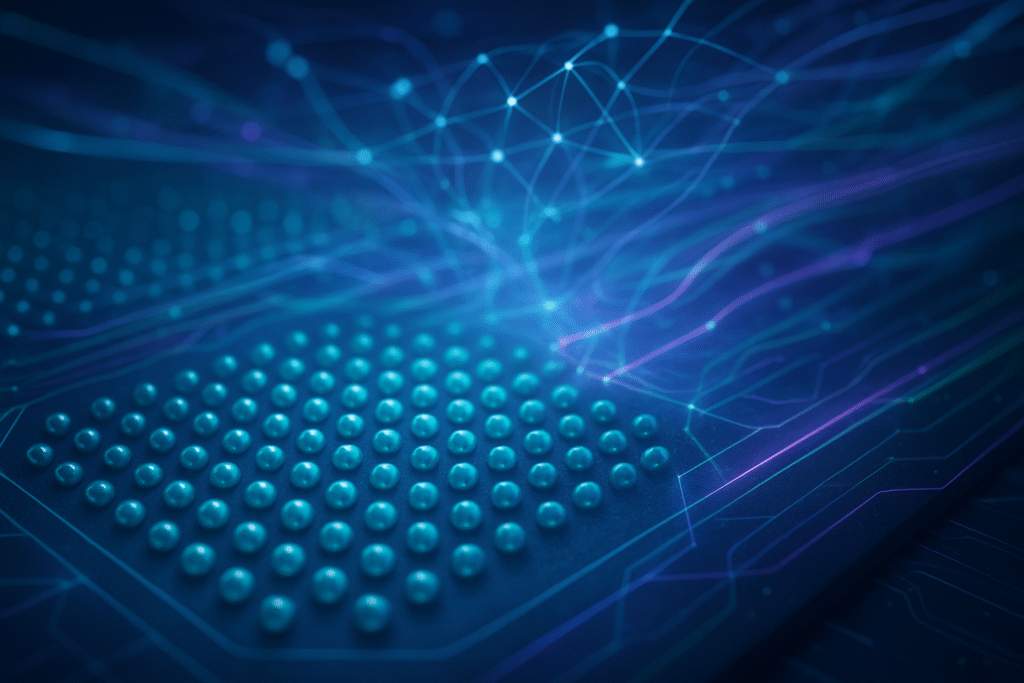
In a groundbreaking series of advancements in 2023, scientists have achieved unprecedented speed and sensitivity in reading individual electrons using silicon-based quantum dots. These breakthroughs, primarily reported in February and September 2023, mark a critical inflection point in the race to build scalable and fault-tolerant quantum computers, with profound implications for the future of artificial intelligence, semiconductor technology, and beyond. By combining high-fidelity measurements with sub-microsecond readout times, researchers have significantly de-risked one of the most challenging aspects of quantum computing, pushing the field closer to practical applications.
These developments are particularly significant because they leverage silicon, a material compatible with existing semiconductor manufacturing processes, promising a pathway to mass-producible quantum processors. The ability to precisely and rapidly ascertain the quantum state of individual electrons is a foundational requirement for quantum error correction, a crucial technique needed to overcome the inherent fragility of quantum bits (qubits) and enable reliable, long-duration quantum computations essential for complex AI algorithms.
Technical Prowess: Unpacking the Quantum Dot Breakthroughs
The core of these advancements lies in novel methods for detecting the spin state of electrons confined within silicon quantum dots. In February 2023, a team of researchers demonstrated a fast, high-fidelity single-shot readout of spins using a compact, dispersive charge sensor known as a radio-frequency single-electron box (SEB). This innovative sensor achieved an astonishing spin readout fidelity of 99.2% in less than 100 nanoseconds, a timescale dramatically shorter than the typical coherence times for electron spin qubits. Unlike previous methods, such as single-electron transistors (SETs) which require more electrodes and a larger footprint, the SEB's compact design facilitates denser qubit arrays and improved connectivity, essential for scaling quantum processors. Initial reactions from the AI research community lauded this as a significant step towards scalable semiconductor spin-based quantum processors, highlighting its potential for implementing quantum error correction.
Building on this momentum, September 2023 saw further innovations, including a rapid single-shot parity spin measurement in a silicon double quantum dot. This technique, utilizing the parity-mode Pauli spin blockade, achieved a fidelity exceeding 99% within a few microseconds. This is a crucial step for measurement-based quantum error correction. Concurrently, another development introduced a machine learning-enhanced readout method for silicon-metal-oxide-semiconductor (Si-MOS) double quantum dots. This approach significantly improved state classification fidelity to 99.67% by overcoming the limitations of traditional threshold methods, which are often hampered by relaxation times and signal-to-noise ratios, especially for relaxed triplet states. The integration of machine learning in readout is particularly exciting for the AI research community, signaling a powerful synergy between AI and quantum computing where AI optimizes quantum operations.
These breakthroughs collectively differentiate from previous approaches by simultaneously achieving high fidelity, rapid readout speeds, and a compact footprint. This trifecta is paramount for moving beyond small-scale quantum demonstrations to robust, fault-tolerant systems.
Industry Ripples: Who Stands to Benefit (and Disrupt)?
The implications of these silicon quantum dot readout advancements are profound for AI companies, tech giants, and startups alike. Companies heavily invested in silicon-based quantum computing strategies stand to benefit immensely, seeing their long-term visions validated. Tech giants such as Intel (NASDAQ: INTC), with its significant focus on silicon spin qubits, are particularly well-positioned to leverage these advancements. Their existing expertise and massive fabrication capabilities in CMOS manufacturing become invaluable assets, potentially allowing them to lead in the production of quantum chips. Similarly, IBM (NYSE: IBM), Google (NASDAQ: GOOGL), and Microsoft (NASDAQ: MSFT), all with robust quantum computing initiatives and cloud quantum services, will be able to offer more powerful and reliable quantum hardware, enhancing their cloud offerings and attracting more developers. Semiconductor manufacturing giants like TSMC (NYSE: TSM) and Samsung (KRX: 005930) could also see new opportunities in quantum chip fabrication, capitalizing on their existing infrastructure.
The competitive landscape is set to intensify. Companies that can successfully industrialize quantum computing, particularly using silicon, will gain a significant first-mover advantage. This could lead to increased strategic partnerships and mergers and acquisitions as major players seek to bolster their quantum capabilities. Startups focused on silicon quantum dots, such as Diraq and Equal1 Laboratories, are likely to attract increased investor interest and funding, as these advancements de-risk their technological pathways and accelerate commercialization. Diraq, for instance, has already demonstrated over 99% fidelity in two-qubit operations using industrially manufactured silicon quantum dot qubits on 300mm wafers, a testament to the commercial viability of this approach.
Potential disruptions to existing products and services are primarily long-term. While quantum computers will initially augment classical high-performance computing (HPC) for AI, they could eventually offer exponential speedups for specific, intractable problems in drug discovery, materials design, and financial modeling, potentially rendering some classical optimization software less competitive. Furthermore, the eventual advent of large-scale fault-tolerant quantum computers poses a long-term threat to current cryptographic standards, necessitating a universal shift to quantum-resistant cryptography, which will impact every digital service.
Wider Significance: A Foundational Shift for AI's Future
These advancements in silicon-based quantum dot readout are not merely technical improvements; they represent foundational steps that will profoundly reshape the broader AI and quantum computing landscape. Their wider significance lies in their ability to enable fault tolerance and scalability, two critical pillars for unlocking the full potential of quantum technology.
The ability to achieve over 99% fidelity in readout, coupled with rapid measurement times, directly addresses the stringent requirements for quantum error correction (QEC). QEC is essential to protect fragile quantum information from environmental noise and decoherence, making long, complex quantum computations feasible. Without such high-fidelity readout, real-time error detection and correction—a necessity for building reliable quantum computers—would be impossible. This brings silicon quantum dots closer to the operational thresholds required for practical QEC, echoing milestones like Google's 2023 logical qubit prototype that demonstrated error reduction with increased qubit count.
Moreover, the compact nature of these new readout sensors facilitates the scaling of quantum processors. As the industry moves towards thousands and eventually millions of qubits, the physical footprint and integration density of control and readout electronics become paramount. By minimizing these, silicon quantum dots offer a viable path to densely packed, highly connected quantum architectures. The compatibility with existing CMOS manufacturing processes further strengthens silicon's position, allowing quantum chip production to leverage the trillion-dollar semiconductor industry. This is a stark contrast to many other qubit modalities that require specialized, expensive fabrication lines. Furthermore, ongoing research into operating silicon quantum dots at higher cryogenic temperatures (above 1 Kelvin), as demonstrated by Diraq in March 2024, simplifies the complex and costly cooling infrastructure, making quantum computers more practical and accessible.
While not direct AI breakthroughs in the same vein as the development of deep learning (e.g., ImageNet in 2012) or large language models (LLMs like GPT-3 in 2020), these quantum dot advancements are enabling technologies for the next generation of AI. They are building the robust hardware infrastructure upon which future quantum AI algorithms will run. This represents a foundational impact, akin to the development of powerful GPUs for classical AI, rather than an immediate application leap. The synergy is also bidirectional: AI and machine learning are increasingly used to tune, characterize, and optimize quantum devices, automating complex operations that are intractable for human intervention as qubit counts scale.
The Horizon: Future Developments and Expert Predictions
Looking ahead from October 2025, the advancements in silicon-based quantum dot readout promise a future where quantum computers become increasingly robust and integrated. In the near term, experts predict a continued focus on improving readout fidelity beyond 99.9% and further reducing readout times, which are critical for meeting the stringent demands of fault-tolerant QEC. We can expect to see prototypes with tens to hundreds of industrially manufactured silicon qubits, with a strong emphasis on integrating more qubits onto a single chip while maintaining performance. Efforts to operate quantum computers at higher cryogenic temperatures (above 1 Kelvin) will continue, aiming to simplify the complex and expensive dilution refrigeration systems. Additionally, the integration of on-chip electronics for control and readout, as demonstrated by the January 2025 report of integrating 1,024 silicon quantum dots, will be a key area of development, minimizing cabling and enhancing scalability.
Long-term expectations are even more ambitious. The ultimate goal is to achieve fault-tolerant quantum computers with millions of physical qubits, capable of running complex quantum algorithms for real-world problems. Companies like Diraq have roadmaps aiming for commercially useful products with thousands of qubits by 2029 and utility-scale machines with many millions by 2033. These systems are expected to be fully compatible with existing semiconductor manufacturing techniques, potentially allowing for the fabrication of billions of qubits on a single chip.
The potential applications are vast and transformative. Fault-tolerant quantum computers enabled by these readout breakthroughs could revolutionize materials science by designing new materials with unprecedented properties for industries ranging from automotive to aerospace and batteries. In pharmaceuticals, they could accelerate molecular design and drug discovery. Advanced financial modeling, logistics, supply chain optimization, and climate solutions are other areas poised for significant disruption. Beyond computing, silicon quantum dots are also being explored for quantum current standards, biological imaging, and advanced optical applications like luminescent solar concentrators and LEDs.
Despite the rapid progress, challenges remain. Ensuring the reliability and stability of qubits, scaling arrays to millions while maintaining uniformity and coherence, mitigating charge noise, and seamlessly integrating quantum devices with classical control electronics are all significant hurdles. Experts, however, remain optimistic, predicting that silicon will emerge as a front-runner for scalable, fault-tolerant quantum computers due to its compatibility with the mature semiconductor industry. The focus will increasingly shift from fundamental physics to engineering challenges related to control and interfacing large numbers of qubits, with sophisticated readout architectures employing microwave resonators and circuit QED techniques being crucial for future integration.
A Crucial Chapter in AI's Evolution
The advancements in silicon-based quantum dot readout in 2023 represent a pivotal moment in the intertwined histories of quantum computing and artificial intelligence. These breakthroughs—achieving unprecedented speed and sensitivity in electron readout—are not just incremental steps; they are foundational enablers for building the robust, fault-tolerant quantum hardware necessary for the next generation of AI.
The key takeaways are clear: high-fidelity, rapid, and compact readout mechanisms are now a reality for silicon quantum dots, bringing scalable quantum error correction within reach. This validates the silicon platform as a leading contender for universal quantum computing, leveraging the vast infrastructure and expertise of the global semiconductor industry. While not an immediate AI application leap, these developments are crucial for the long-term vision of quantum AI, where quantum processors will tackle problems intractable for even the most powerful classical supercomputers, revolutionizing fields from drug discovery to financial modeling. The symbiotic relationship, where AI also aids in the optimization and control of complex quantum systems, further underscores their interconnected future.
The long-term impact promises a future of ubiquitous quantum computing, accelerated scientific discovery, and entirely new frontiers for AI. As we look to the coming weeks and months from October 2025, watch for continued reports on larger-scale qubit integration, sustained high fidelity in multi-qubit systems, further increases in operating temperatures, and early demonstrations of quantum error correction on silicon platforms. Progress in ultra-pure silicon manufacturing and concrete commercialization roadmaps from companies like Diraq and Quantum Motion (who unveiled a full-stack silicon CMOS quantum computer in September 2025) will also be critical indicators of this technology's maturation. The rapid pace of innovation in silicon-based quantum dot readout ensures that the journey towards practical quantum computing, and its profound impact on AI, continues to accelerate.
This content is intended for informational purposes only and represents analysis of current AI developments.
TokenRing AI delivers enterprise-grade solutions for multi-agent AI workflow orchestration, AI-powered development tools, and seamless remote collaboration platforms.
For more information, visit https://www.tokenring.ai/.





